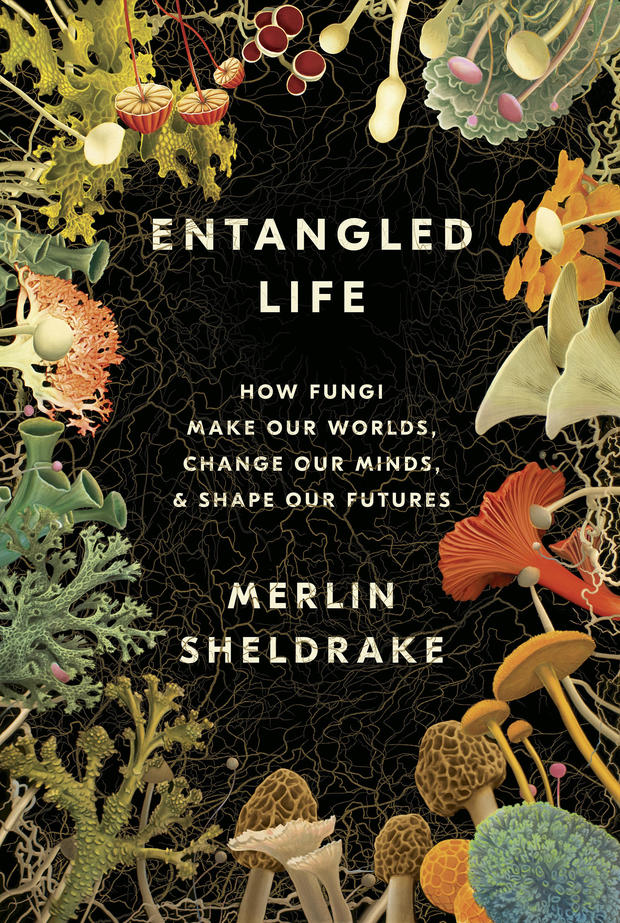Book excerpt: "Entangled Life," on how fungi shape our future
Biologist and author Merlin Sheldrake's book, "Entangled Life: How Fungi Make Our Worlds, Change Our Minds & Shape Our Futures" (Random House), explores the fascinating relationships between humans and the fungal organisms upon which so much of life on Earth depends.
Read an excerpt from "Entangled Life" below, and don't miss Conor Knighton's interview with Merlin Sheldrake on "CBS Sunday Morning" February 7!
Many of the most dramatic events on Earth have been – and continue to be –a result of fungal activity. Plants only made it out of the water around five hundred million years ago because of their collaboration with fungi, which served as their root systems for tens of million years until plants could evolve their own. Today, more than ninety percent of plants depend on mycorrhizal fungi – from the Greek words for fungus (mykes) and root (rhiza) – which can link trees in shared networks sometimes referred to as the "wood wide web." This ancient association gave rise to all recognizable life on land, the future of which depends on the continued ability of plants and fungi to form healthy relationships.
To this day, new ecosystems on land are founded by fungi. When volcanic islands are made or glaciers retreat to reveal bare rock, lichens (pronounced LY ken) – a union of fungi and algae or bacteria – are the first organisms to establish themselves and to make the soil in which plants subsequently take root. In well-developed ecosystems soil would be rapidly sluiced off by rain were it not for the dense mesh of fungal tissue that holds it together. There are few pockets of the globe where fungi can't be found; from deep sediments on the seafloor, to the surface of deserts, to frozen valleys in Antarctica, to our guts and orifices. Tens to hundreds of species can exist in the leaves and stems of a single plant. These fungi weave themselves through the gaps between plant cells in an intimate brocade and help to defend plants against disease. No plant grown under natural conditions has been found without these fungi; they are as much a part of planthood as leaves or roots.
The ability of fungi to prosper in such a variety of habitats depends on their diverse metabolic abilities. Metabolism is the art of chemical transformation. Fungi are metabolic wizards and can explore, scavenge, and salvage ingeniously, their abilities rivaled only by bacteria. Using cocktails of potent enzymes and acids, fungi can break down some of the most stubborn substances on the planet, from lignin, wood's toughest component, to rock; crude oil; polyurethane plastics; and the explosive TNT. Few environments are too extreme. A species isolated from mining waste is one of the most radiation-resistant organisms ever discovered and may help to clean up nuclear waste sites. The blasted nuclear reactor at Chernobyl is home to a large population of such fungi. A number of these radiotolerant species even grow toward radioactive "hot" particles, and appear to be able to harness radiation as a source of energy, as plants use the energy in sunlight.
…
We all live and breathe fungi, thanks to the prolific abilities of fungal fruiting bodies to disperse spores. Some species discharge spores explosively, which accelerate ten thousand times faster than a space shuttle directly after launch, reaching speeds of up to a hundred kilometers per hour – some of the quickest movements achieved by any living organism. Other species of fungi create their own microclimates: Spores are carried upward by a current of wind generated by mushrooms as water evaporates from their gills. Fungi produce around fifty megatons of spores each year – equivalent to the weight of five hundred thousand blue whales – making them the largest source of living particles in the air. Spores are found in clouds and influence the weather by triggering the formation of the water droplets that form rain and the ice crystals that form snow, sleet, and hail.
Some fungi, like the yeasts that ferment sugar into alcohol and cause bread to rise, consist of single cells that multiply by budding into two. However, most fungi form networks of many cells known as hyphae: fine tubular structures that branch, fuse, and tangle into the anarchic filigree of mycelium. Mycelium describes the most common of fungal habits, better thought of not as a thing but as a process: an exploratory, irregular tendency. Water and nutrients flow through ecosystems within mycelial networks. The mycelium of some fungal species is electrically excitable and conducts waves of electrical activity along hyphae, analogous to the electrical impulses in animal nerve cells.
Hyphae make mycelium, but they also make more specialized structures. Fruiting bodies, such as mushrooms, arise from the felting together of hyphal strands. These organs can perform many feats besides expelling spores. Some, like truffles, produce aromas that have made them among the most expensive foods in the world. Others, like shaggy ink cap mushrooms (Coprinus comatus), can push their way through asphalt and lift heavy paving stones, although they are not themselves a tough material. Pick an ink cap and you can fry it up and eat it. Leave it in a jar, and its bright white flesh will deliquesce into a pitch-black ink over the course of a few days (the illustrations in this book were drawn with Coprinus ink).
…
Radical fungal technologies can help us respond to some of the many problems that arise from ongoing environmental devastation. Antiviral compounds produced by fungal mycelium reduce colony collapse disorder in honeybees. Voracious fungal appetites can be deployed to break down pollutants, such as crude oil from oil spills, in a process known as mycoremediation. In mycofiltration, contaminated water is passed through mats of mycelium, which filter out heavy metals and break down toxins. In mycofabrication, building materials and textiles are grown out of mycelium and replace plastics and leather in many applications. Fungal melanins, the pigments produced by radio-tolerant fungi, are a promising new source of radiation-resistant biomaterials.
Human societies have always pivoted around prodigious fungal metabolisms. A full litany of the chemical accomplishments of fungi would take months to recite. Yet despite their promise, and central role in many ancient human fascinations, fungi have received a tiny fraction of the attention given to animals and plants. The best estimate suggests that there are between 2.2 and 3.8 million species of fungi in the world – six to ten times the estimated number of plant species – meaning that a mere six percent of all fungal species have been described. We are only just beginning to understand the intricacies and sophistications of fungal lives.
Excerpt from "Entangled Life," copyright © 2020 by Merlin Sheldrake. All rights reserved. Published in the United States by Random House, an imprint and division of Penguin Random House LLC, New York.
For more info:
- "Entangled Life: How Fungi Make Our Worlds, Change Our Minds & Shape Our Futures" by Merlin Sheldrake (Random House), in Hardcover, eBook and Audio formats, available via Amazon and Indiebound
- merlinsheldrake.com






